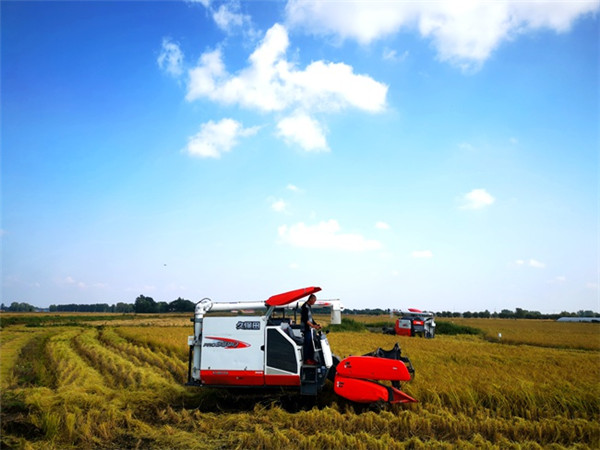Jiutai follows distinctive path for rural revitalization

Modern harvesters trundle across rice paddy fields in Hongguang village in Jilin province. [Photo provided to chinadaily.com.cn]
In recent years, the Jiutai district of Changchun -- capital city of Northeast China's Jilin province -- has followed its own development path, by combing modern agriculture and culture and tourism to promote rural revitalization in its own, very distinctive way.
Through the implementation of its own blend of rural revitalization strategy, Jiutai has been achieving big things.
For example, in Hongguang village, a total of 268 hectares of high standard farmland have been established.
The Hongguang professional cooperative for agricultural mechanization production has implemented a development plan of what it calls "farmlands, soil, water, road, electricity and network".
This has realized large-scale, standardized and efficient rice planting.
The modern agricultural demonstration base of the village has implemented an operation mode involving mechanized production and standardized and large-scale operation.
The rate of rice transplanting by machines has increased to 98 percent, the machine harvesting rate has increased to 95 percent and the comprehensive overall mechanization rate of the rice field operation has increased to 98 percent.
But at the same time, a whole host of other less conventional measures have also been introduced.

A farmer shows off one of the thousands of crabs that are being raised in the rice fields. [Photo provided to chinadaily.com.cn]
These include the utilization of the rice husks that are returned to the field, organic prevention and control measures for diseases and insect pests, raising ducks and crabs in the fields, as well as fish farming there.
All these not only reduce production costs, but also improves economic benefits, which is conducive to the sustainable development of agriculture and ensuring the freshness and taste of the rice.
In addition, the waste rice husks have also been used to produce facial masks, cat litter, weight loss fiber food, health food and rice bran oil. The rice straw is also being processed into tatami mats for export, realizing the comprehensive utilization of rice by-products.
Many villages in Jiutai district, while developing innovative industries, have improved their environment and developed a rural tourism industry.
They have made efforts to promote the integration of industry and the rural living environment and made every effort to create a beautiful countryside that blends agricultural tourism, leisure and health care, a sustainable environment and industrial prosperity.




 Mail
Mail Print
Print Larger
Larger
